
Delta Air Lines Flight 1141 was a scheduled domestic passenger flight between Dallas/Fort Worth, Texas and Salt Lake City, Utah. On August 31, 1988, the flight, using a Boeing 727-200 series aircraft, crashed during takeoff, resulting in 14 deaths and 76 injuries of the 108 on board.

American Airlines Flight 1420 was a flight from Dallas/Fort Worth International Airport (DFW) to Little Rock National Airport in the United States. On June 1, 1999, the McDonnell Douglas MD-82 operating as Flight 1420 overran the runway upon landing in Little Rock and crashed. 9 of the 145 people aboard were immediately killed—the captain and 8 passengers.
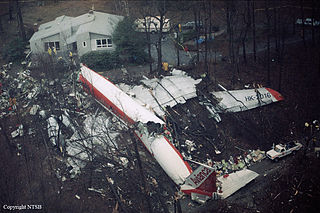
Avianca Flight 052 was a regularly scheduled flight from Bogotá, Colombia, to New York City, United States, via Medellín, Colombia, that crashed on January 25, 1990, at 21:34 (UTC−05:00). The Boeing 707 flying this route ran out of fuel after a failed attempt to land at John F. Kennedy International Airport (JFK), causing the aircraft to crash onto a hillside in the small village of Cove Neck, New York, on the north shore of Long Island. Eight of the nine crew members and 65 of the 149 passengers on board were killed. The National Transportation Safety Board (NTSB) determined that the crash occurred due to the flight crew failing to properly declare a fuel emergency, failure to use an airline operational control dispatch system, inadequate traffic flow management by the Federal Aviation Administration (FAA), and the lack of standardized understandable terminology for pilots and controllers for minimum and emergency fuel states.
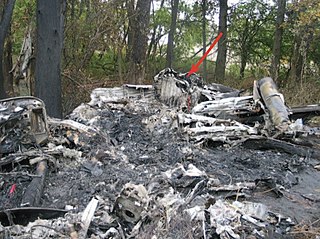
Corporate Airlines Flight 5966 was a scheduled passenger flight from St. Louis, Missouri to Kirksville, Missouri. On October 19, 2004, the Jetstream 32 aircraft operating the flight crashed on approach to Kirksville Regional Airport as a result of pilot error, killing 13 of the 15 people aboard.
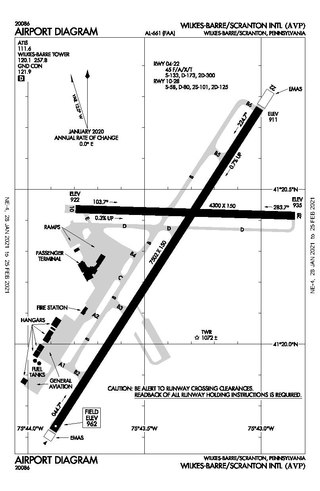
Wilkes-Barre/Scranton International Airport is mostly in Pittston Township, Pennsylvania, and spans the border between Luzerne County and Lackawanna County. It is owned and operated by the two counties; it is about 7 miles from Scranton and 8 miles from Wilkes-Barre. It is the fifth-largest airport in Pennsylvania by passenger count and calls itself "your gateway to Northeastern Pennsylvania and the Pocono Mountains".

Continental Airlines Flight 1713 was a commercial airline flight that crashed while taking off in a snowstorm from Stapleton International Airport in Denver, Colorado, on November 15, 1987. The Douglas DC-9 airliner, operated by Continental Airlines, was making a scheduled flight to Boise, Idaho. Twenty-five passengers and three crew members died in the crash.

Air New Orleans was an airline based in Birmingham, Alabama that was conceived as a commuter air carrier to provide scheduled passenger service to cities throughout the Southeastern United States from Texas to Florida. The airline was founded in 1981 in Panama City, Florida and operated scheduled passenger service between 1981 and 1988.

EgyptAir Flight 990 (MS990/MSR990) was a scheduled flight from Los Angeles International Airport to Cairo International Airport, with a stop at John F. Kennedy International Airport, New York City. On October 31, 1999, the Boeing 767-300ER operating the route crashed into the Atlantic Ocean about 60 miles (100 km) south of Nantucket Island, Massachusetts, killing all 217 passengers and crew on board, making it the deadliest aviation disaster for EgyptAir, and also the second-deadliest aviation accident involving a Boeing 767 aircraft, behind Lauda Air Flight 004.

In aviation, a preflight checklist is a list of tasks that should be performed by pilots and aircrew prior to takeoff. Its purpose is to improve flight safety by ensuring that no important tasks are forgotten. Failure to correctly conduct a preflight check using a checklist is a major contributing factor to aircraft accidents.

The British Aerospace Jetstream is a small twin turboprop airliner, with a pressurised fuselage, developed as the Jetstream 31 from the earlier Handley Page Jetstream. A larger version of the Jetstream was also manufactured, the British Aerospace Jetstream 41.

United Express Flight 6291 was a regularly scheduled United Express flight from Dulles International Airport near Washington, D.C. to Port Columbus International Airport in Columbus, Ohio. It was a service operated by Atlantic Coast Airlines on behalf of United Express.

Northwest Airlink Flight 5719 was a flight from Minneapolis-Saint Paul International Airport to International Falls Airport in International Falls, Minnesota with a scheduled intermediate stop at Chisholm-Hibbing Airport in Hibbing, Minnesota. On December 1, 1993, the Jetstream 31, operated by Express Airlines I as Northwest Airlink, collided with a group of trees in a forest during final approach to Hibbing, and crashed into two ridges northwest of the airport, killing all sixteen passengers and the two pilots on board.
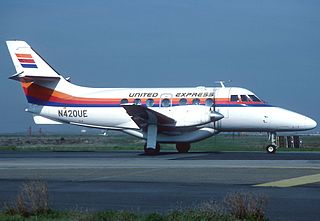
United Express Flight 2415 was a regularly scheduled flight in the northwest United States from Seattle to Pasco, Washington, operated using a BAe Jetstream 31. Late on Tuesday, December 26, 1989, Flight 2415 crashed while attempting to land at Pasco's Tri-Cities Airport, killing both pilots and all four passengers aboard.
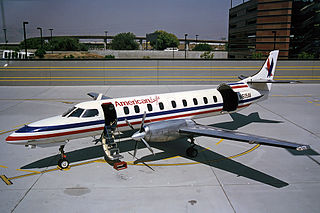
AVAir Flight 3378, was a scheduled flight under the American Eagle branding from Raleigh–Durham International Airport to Richmond International Airport which crashed after takeoff from Raleigh-Durham International Airport late on the night of February 19, 1988. All 12 people on board were killed in the accident.

Flagship Airlines Flight 3379 was a scheduled flight under the American Eagle branding from Piedmont Triad International Airport to Raleigh–Durham International Airport during which a British Aerospace Jetstream crashed while executing a missed approach to the Raleigh–Durham International Airport on the evening of Tuesday, December 13, 1994. The two pilots and 13 passengers died in the crash; five passengers survived with serious injuries.

The 1972 Puerto Rico DC-7 crash was an aviation accident that occurred on December 31, 1972, in Carolina, Puerto Rico. As a result of inadequate maintenance, the aircraft's No. 2 engine failed after takeoff. After initiating a turn to return to the airport, the aircraft eventually descended into, or attempted to ditch into, the ocean a mile offshore. All five people on board died, including baseball legend Roberto Clemente. The crash site was listed on the US National Register of Historic Places in 2022.

On the evening of April 1, 1993, NASCAR champion Alan Kulwicki was killed in an aviation accident when the Swearingen Merlin III twin turboprop he was traveling in crashed near Blountville, Tennessee, while on approach to the nearby Tri-Cities Regional Airport. All four people on board, including two executives of the Hooters restaurant chain, were killed.

Atlas Air Flight 3591 was a scheduled domestic cargo flight under the Amazon Air banner between Miami International Airport and George Bush Intercontinental Airport in Houston. On February 23, 2019, the Boeing 767-375ER(BCF) used for this flight crashed into Trinity Bay during approach into Houston, killing the two crew members and a single passenger on board. The accident occurred near Anahuac, Texas, east of Houston, shortly before 12:45 CST (18:45 UTC). This was the first fatal crash of a Boeing 767 freighter.

Miami Air International Flight 293 was a military charter from Guantanamo Bay to Naval Air Station Jacksonville, operated by Miami Air International. On May 3, 2019, the Boeing 737-800 aircraft operating the flight overran the runway on landing. Twenty-one people were injured. The aircraft was written off, making it the 17th loss of a Boeing 737-800. The National Transportation Safety Board (NTSB) attributed the accident to hydroplaning caused by heavy rainfall on the ungrooved runway; although the pilots were found to have made a series of errors during final approach and landing, the NTSB concluded that these errors had little effect on the final outcome, as the aircraft would have been unable to stop even if the landing had been executed properly.

Transair Flight 810 was a Boeing 737-200 converted freighter aircraft, owned and operated by Rhoades Aviation under the Transair trade name, on a short cargo flight en route from Honolulu International Airport to Kahului Airport on the neighboring Hawaiian island of Maui. Immediately after an early morning takeoff on July 2, 2021, one of its two Pratt & Whitney JT8D turbofan engines faltered, and the first officer, who was flying the aircraft, reduced power to both. The two pilots—who were the only aircraft occupants—began executing the Engine Failure or Shutdown checklist, but became preoccupied with talking to air traffic control (ATC) and performing other flying tasks, and never reached the section of the checklist where the failing engine was to be positively identified and shut down. The captain assumed control but misidentified the failing engine, increased power to that engine, and did not increase power to the other, properly functioning engine. Convinced that neither engine was working properly and unable to maintain altitude with one engine faltering and the other idling, the pilots ditched off the coast of Oahu about 11 minutes into the flight.





















